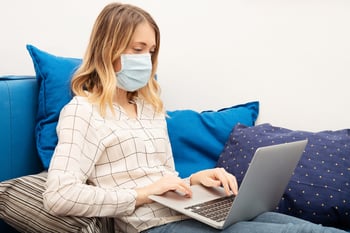Choosing the perfect stock photo can be difficult on a normal day. While scrolling through endless options, you may find yourself questioning “does this person have the right facial expression?” or “does the style of this photo align with the brand?” But during a global pandemic, there are a few more things you should keep in mind when selecting the right images for your project.
Whether you are directly addressing COVID-19 or not, make sure your photography selections are relevant, appropriate and thoughtful. And although the tips below might seem like common sense, they’re all real-life examples we’ve seen over the past few weeks.
Don’t let your brand go viral for an insensitive or just plain stupid photo choice!
Use scientifically accurate imagery
Just because you search for images using the phrase “coronavirus” doesn’t mean the results will be scientifically accurate.
For example, this spiky rubber thing is a dryer ball or a dog toy. Not the Coronavirus. (Yes, we’ve seen at least two companies make that mistake in email marketing recently.)
Bad Photo Example

By contrast, this is a 3D rendering of the virus, straight from the CDC website. In fact, they have a whole image library of scientifically accurate images that you can use for free!
Good Photo Example

Be culturally sensitive
Yes, the first known case of COVID-19 originated in a Chinese providence…but using pictures of sick Asian people wearing masks is still culturally insensitive. On that note, don’t show any sick person working from home…sick employees should rest! That means no “work-from-home-wearing-a-mask” images, kay? Are you wearing an N95 respirator right now in your home office? Didn’t think so.
Bad Photo Examples


Instead, pick more realistic #WFH images. Show employees working on a laptop at the kitchen counter or using their cell phone on the couch. Annoying kids making a mess in the background is optional.
Pay attention to PPE
When using photos of medical professionals, be mindful of what they are wearing. Using a photo that shows a doctor or nurse treating a patient without full personal protective equipment (PPE) could come off as out of touch. Even a grocery store clerk or a shopper in a retail store who isn’t wearing a mask isn’t reflective of the current reality. Instead, make sure that people who are out in a public setting are observing social distancing rules and/or wearing an appropriate level of PPE.
Bad Photo Examples


Avoid using photos of large groups or gatherings
While we all hope that life will return to normal someday soon, our current reality is that we can’t gather in large groups of people. Using images of large crowds is not only a harsh reminder of our social isolation, but could also suggest activities that go against current social distancing guidelines that are in place to protect us all. Keep the social distancing guidelines in mind, and choose images that reflect those practices.
Bad Photo Example

Stop using photos of people shaking hands…maybe even forever
What was once a friendly greeting is now the kiss of Coronavirus. Handshakes are out—in 2020 we are opting for a peace sign, a thumbs up or an elbow bump if you’re lucky. Hershey was early to recognize the sensitivity to such interactions and pulled two ads in early March that featured people shaking hands and hugging.
Bad Photo Example

While this may seem like an overcorrection to some, this kind of mindfulness to the current climate will only pay off in the long run. Especially since Dr. Anthony Fauci, Director of the National Institute of Allergy and Infectious Diseases, suggested to NPR that Americans should never shake hands again!
We get it…the pool of generic (yet oddly specific) stock photos available on the internet is already tough to sift through. But following the guidelines above will help you find the most appropriate way to visually supplement your materials while being mindful of the strange state we are currently in.





